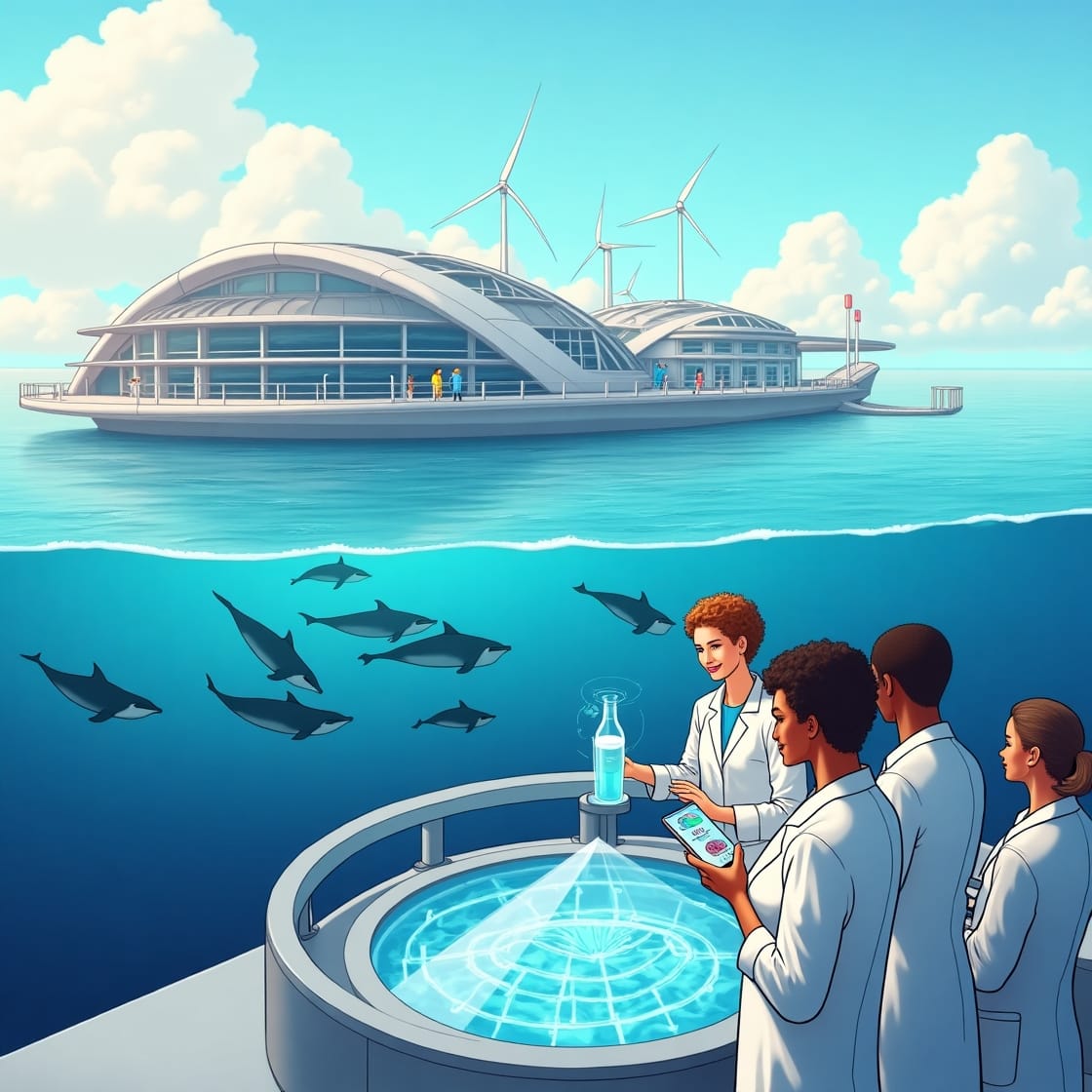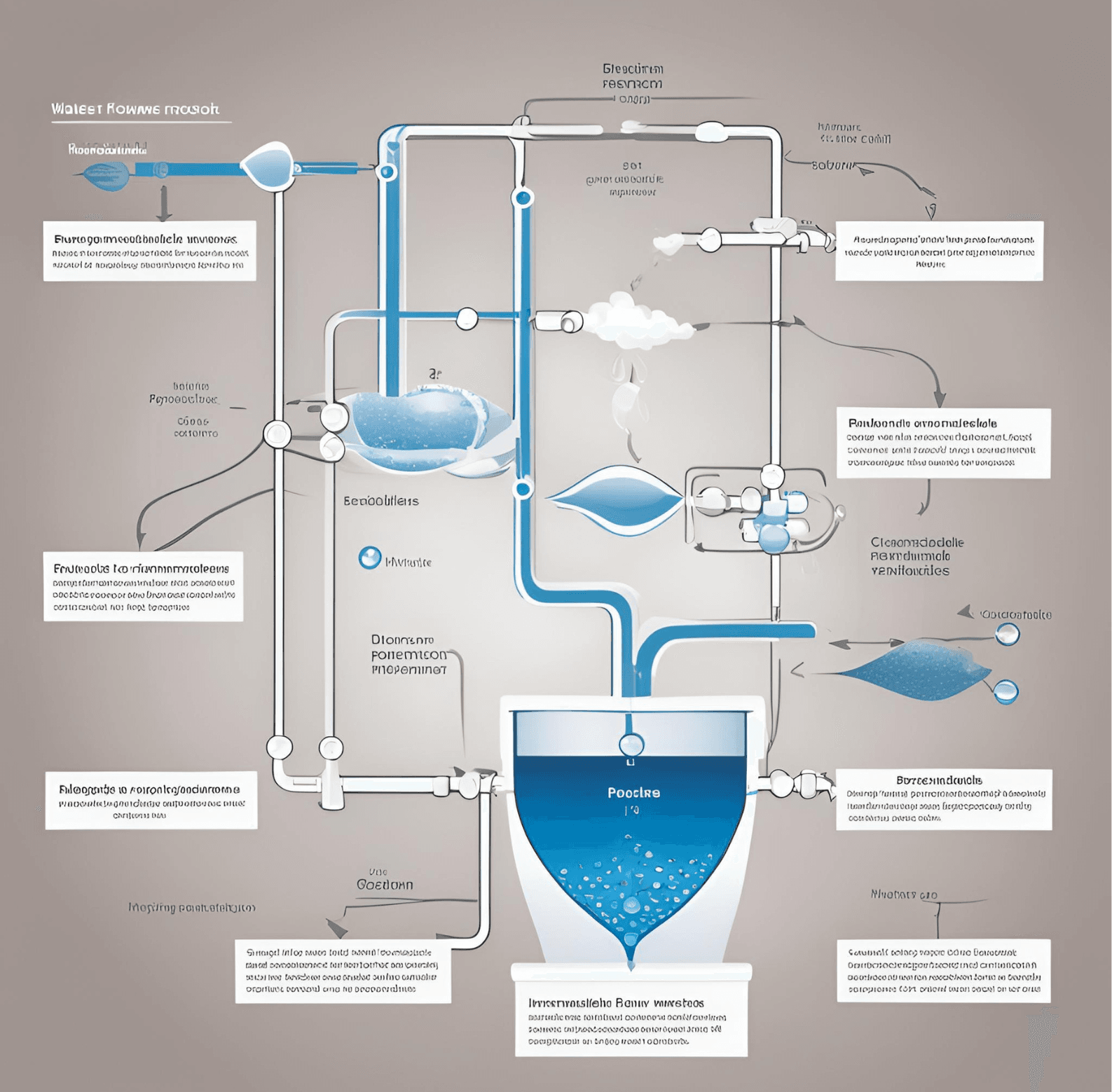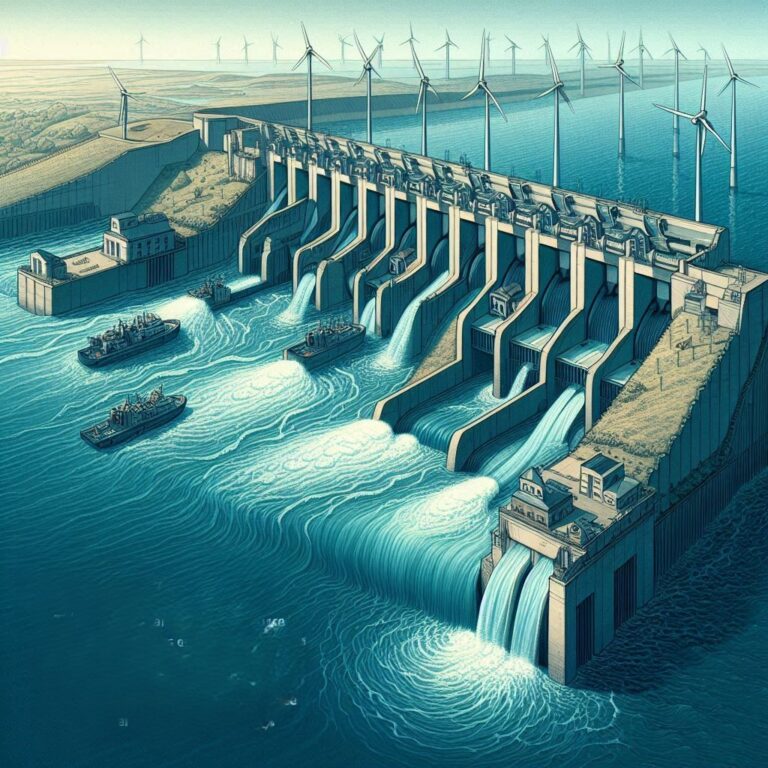Introduction
Water scarcity has emerged as one of the most critical and urgent challenges facing humanity today. According to the United Nations, by 2025, an estimated 1.8 billion people will experience absolute water scarcity, and nearly two-thirds of the global population could be living under water-stressed conditions. Given the vast reserves of seawater, ocean-based desalination has emerged as a promising solution to address the growing demand for freshwater resources.
What This Blog Covers
This blog explores:
- How ocean-based desalination works and how it differs from other desalination methods.
- The top 10 largest desalination plants in the world producing billions of gallons of clean water daily.
- Ongoing desalination plant projects that are revolutionizing water infrastructure.
- Thermal desalination technologies, including multistage flash distillation (MSF), multiple-effect distillation (MED), and thermal vapor compression (TVC).
- Answering a fundamental question: Can you purify sea water?

By the end of this article, you’ll gain deep insights into ocean-based desalination technologies, their efficiency, challenges, and future advancements.
What Is Ocean-Based Desalination?
Understanding the Desalination Process
Desalination is the process of removing salt, minerals, and impurities from seawater to make it drinkable or usable for industrial and agricultural purposes. This is done through membrane-based filtration (Reverse Osmosis) or thermal-based evaporation (Thermal Desalination).
Key advantages of ocean-based desalination:
✅ Provides an unlimited supply of water from oceans.
✅ Reduces dependence on freshwater sources (lakes, rivers, and groundwater).
✅ Essential for water-scarce regions such as the Middle East, California, and Australia.
How Is Ocean-Based Desalination Different from Other Desalination Methods?
Desalination is used for different types of saline water sources, each requiring unique processing techniques.
Brackish Water Desalination
Brackish water is less saline than seawater but still undrinkable without treatment. It is typically found in rivers, estuaries, underground aquifers, and lakes.
- Salinity Levels: Around 1,000–10,000 mg/L of dissolved salts (seawater has ~35,000 mg/L).
- Treatment Process: Often uses Reverse Osmosis (RO) membranes, which require lower energy than ocean desalination.
- Energy Requirements: Less than half of ocean desalination since lower salinity water requires less pressure.
Ocean-Based Desalination
Ocean desalination treats high-salinity seawater, requiring advanced purification technology.
- Salinity Levels: Around 35,000 mg/L of dissolved salts.
- Treatment Process: Uses Reverse Osmosis (RO) or Thermal Desalination.
- Energy Requirements: Higher due to intensive filtration or heat evaporation.
Iceberg Towing and Atmospheric Water Harvesting (Experimental Methods)
Some alternative water sourcing techniques include towing icebergs to regions in need or harvesting water from humidity in the air, but these remain largely experimental due to high logistical challenges and costs.

Key Desalination Technologies
Desalination technologies fall into two broad categories:
- Reverse Osmosis (RO) Desalination
Reverse Osmosis (RO) is the most widely used desalination method worldwide. It works by pushing seawater through a semi-permeable membrane that filters out salt, bacteria, and contaminants.
🔹 How It Works:
- Seawater is drawn into the system and pre-treated to remove large particles and debris.
- High-pressure pumps force the seawater through the RO membrane, leaving only freshwater behind.
- The remaining saltwater concentrate (brine) is then discharged back into the ocean.
🔹 Advantages:
✅ Energy-efficient compared to thermal desalination methods.
✅ Can remove 99% of salt, bacteria, and impurities.
✅ Over 60% of global desalination plants use RO technology.
🔹 Challenges:
❌ RO membranes require frequent maintenance and replacement.
❌ Produces high amounts of brine waste, which can impact marine ecosystems.
- Thermal Desalination Technologies
Thermal desalination relies on heat-based evaporation to remove salt from water. It is commonly used in Middle Eastern countries, where waste heat from power plants is available.
🔹 Types of Thermal Desalination:
a) Multistage Flash Distillation (MSF)
- Uses high-pressure steam to rapidly evaporate seawater in multiple stages.
- The vapor is condensed into freshwater, while the salt remains behind.
- Commonly used in Saudi Arabia and the UAE due to energy subsidies.
b) Multiple-Effect Distillation (MED)
- Works similarly to MSF but recycles the heat multiple times, making it more efficient.
- Found in large-scale industrial desalination plants.
c) Thermal Vapor Compression (TVC)
- Uses compressed steam to enhance evaporation efficiency.
- Suitable for regions with surplus thermal energy, such as oil-rich nations.
🔹 Advantages of Thermal Desalination:
✅ More effective in areas where waste heat is available.
✅ Produces high-purity freshwater.
🔹 Challenges:
❌ High energy costs compared to Reverse Osmosis.
❌ Not ideal for regions lacking excess thermal energy.
Top 10 Largest Desalination Plants in the World
Desalination has become a critical solution for addressing global water shortages, especially in arid regions. The Top 10 Largest Desalination Plants in the World produce millions of cubic meters of fresh water daily, supplying both residential and industrial needs. Below is a list of the largest desalination plants, along with their key specifications:
| Name & Location | Capacity (MGD / m³ per day) | Technology Used | Year Commissioned | Unique Features |
|---|---|---|---|---|
| Ras Al-Khair (Saudi Arabia) | 264 MGD (1M m³/day) | Hybrid (RO + MSF) | 2014 | Largest hybrid desalination plant; also generates power |
| Sorek (Israel) | 164 MGD (624,000 m³/day) | Reverse Osmosis (RO) | 2013 | One of the most efficient RO plants globally |
| Taweelah (UAE) | 200 MGD (909,000 m³/day) | Reverse Osmosis (RO) | 2022 | Largest RO-based desalination plant |
| Shuaiba 3 (Saudi Arabia) | 250,000 m³/day | Multi-Stage Flash (MSF) | 2009 | Supplies Mecca, Jeddah, and Taif |
| Jebel Ali M (UAE) | 80,000 m³/day per unit | Multi-Stage Flash (MSF) | 2014 | Named "Desalination Plant of the Year" in 2014 |
| Tuas 3 (Singapore) | 136 MGD (504,000 m³/day) | Reverse Osmosis (RO) | 2018 | Integrates RO with solar energy |
| Carlsbad (USA) | 50 MGD (189,000 m³/day) | Reverse Osmosis (RO) | 2015 | Largest desalination plant in the Western Hemisphere |
| Fujairah 2 (UAE) | 130 MGD (492,000 m³/day) | Hybrid (RO + MSF) | 2010 | Co-located with a power plant |
| Sydney (Australia) | 66 MGD (250,000 m³/day) | Reverse Osmosis (RO) | 2010 | Designed to operate on renewable energy |
| Melbourne (Australia) | 110 MGD (410,000 m³/day) | Reverse Osmosis (RO) | 2012 | Supplies 30% of Melbourne’s water demand |
These Top 10 Largest Desalination Plants in the World play a vital role in securing freshwater supplies globally.
Current and Future Desalination Plant Projects
As water scarcity intensifies, new Desalination Plant Projects are emerging worldwide. Some major ongoing and upcoming projects include:
Red Sea Project (Saudi Arabia)
- Capacity: 50,000 m³/day
- Technology: Solar-powered Reverse Osmosis
- Estimated Cost: $1.5 billion
- Completion Date: 2025
- Innovation: Uses 100% renewable energy to minimize environmental impact.
Huntington Beach Desalination Plant (California, USA)
- Capacity: 50 MGD (189,000 m³/day)
- Technology: Reverse Osmosis
- Estimated Cost: $1.4 billion
- Completion Date: TBD (Facing regulatory hurdles)
- Innovation: Designed to supply 400,000 residents.
Perth Seawater Desalination Plant Expansion (Australia)
- Capacity: 100 MGD (378,000 m³/day)
- Technology: Reverse Osmosis
- Estimated Cost: $2 billion
- Completion Date: 2026
- Innovation: Will be powered by wind and solar energy.
Agadir Desalination Plant (Morocco)
- Capacity: 75 MGD (283,000 m³/day)
- Technology: Reverse Osmosis
- Estimated Cost: $500 million
- Completion Date: 2025
- Innovation: Will supply drinking water and irrigation water for agriculture.
Ras Al-Khair Expansion (Saudi Arabia)
- Capacity: Additional 400 MGD (1.5M m³/day)
- Technology: Hybrid (RO + Thermal)
- Estimated Cost: $3 billion
- Completion Date: 2027
- Innovation: Aims to become the largest desalination facility globally.
New Desalination Plant Projects are increasingly incorporating renewable energy sources, such as solar-powered desalination plants and floating desalination units, to enhance efficiency and sustainability
Can You Purify Sea Water? Exploring Desalination Technologies
The question “Can You Purify Sea Water?” has a definitive answer—yes! Seawater purification, or desalination, is achieved using two primary methods: Reverse Osmosis (RO) and Thermal Desalination. Each method plays a crucial role in providing fresh water, especially in arid regions and coastal areas.
Reverse Osmosis (RO) Desalination
RO is the most widely used seawater purification method, accounting for over 60% of global desalination plants. It involves:
Process: High-pressure pumps force seawater through a semi-permeable membrane, which filters out salt and impurities while allowing clean water molecules to pass through.

Pros:
- More energy-efficient than thermal desalination.
- Lower operational costs in the long term.
- Can be used for both brackish water and seawater.
Cons:
- Membrane fouling: Accumulation of salt and organic matter can reduce efficiency.
- High maintenance: Requires frequent membrane replacements and chemical cleaning.
Thermal Desalination
Thermal desalination mimics the natural water cycle by evaporating seawater and condensing it into fresh water. There are two main types:
Multi-Stage Flash (MSF): Seawater is heated and passed through multiple chambers where it “flashes” into steam due to reduced pressure.
Multi-Effect Distillation (MED): Seawater is heated in successive stages, with each stage using the heat from the previous one, improving efficiency.
Pros:
- Highly effective for treating high-salinity water.
- Durable systems with fewer issues related to membrane fouling.
Cons:
- Energy-intensive: Requires large amounts of heat, making it costly in regions with expensive fuel.
- Environmental impact: Produces highly concentrated brine waste.
Comparison of RO and Thermal Desalination
| Factor | Reverse Osmosis (RO) | Thermal Desalination (MSF, MED) |
|---|---|---|
| Energy Consumption | Lower (3–5 kWh/m³) | Higher (6–15 kWh/m³) |
| Cost | Lower operating costs | Expensive to run |
| Suitability | Ideal for coastal areas with access to electricity | Works well in energy-rich regions (Middle East) |
| Environmental Impact | Less waste, but requires chemicals | High brine discharge, thermal pollution |
The answer to “Can You Purify Sea Water?” is yes, but the choice of technology depends on energy availability, cost, and environmental considerations.
Thermal Desalination: A Deep Dive
Thermal desalination, also known as evaporative desalination, is a key technology for water purification, particularly in energy-rich regions like the Middle East. A Thermal Desalination Plant operates by heating seawater, evaporating the water content, and condensing the steam into freshwater.
How Does Thermal Desalination Work?
- Heating: Seawater is heated in large chambers.
- Evaporation: The heated water enters low-pressure chambers, where it rapidly vaporizes.
- Condensation: The vapor is cooled and collected as pure freshwater.
- Brine Discharge: The remaining concentrated saltwater (brine) is discharged back into the sea.
Types of Thermal Desalination
- Multi-Stage Flash (MSF): Seawater passes through multiple chambers at decreasing pressures, causing it to flash into steam.
- Multi-Effect Distillation (MED): Uses a series of heat exchangers to evaporate water in multiple stages, reducing energy consumption.
- Thermal Vapor Compression (TVC): Uses steam ejectors to compress and reuse vapor, improving efficiency.
Advantages of Thermal Desalination
- Reliable in high-salinity environments: Works well with highly saline waters, where RO struggles.
- Durability: Longer lifespan compared to membrane-based systems.
- Integration with power plants: Often co-located with fossil fuel plants to utilize waste heat.
Challenges of Thermal Desalination
- Energy-intensive: Requires 6–15 kWh per cubic meter of water, making it less efficient than RO.
- Brine discharge: Produces concentrated salt waste, which can harm marine ecosystems.
- Expensive operation: High energy costs make it viable mostly in oil-rich nations.
Case Study: Ras Al-Khair Thermal Desalination Plant
- Location: Saudi Arabia
- Capacity: 264 MGD (1 million m³/day)
- Technology: Hybrid (MSF + RO)
- Significance: Largest Thermal Desalination Plant in the world, providing water and electricity to millions.
Despite challenges, Thermal Desalination Plants remain crucial in regions where energy is abundant but freshwater is scarce. New innovations, such as solar-powered desalination, are improving efficiency and sustainability.
Environmental and Economic Considerations
Desalination has emerged as a promising solution for addressing the growing demand for fresh water. However, several environmental and economic concerns need to be addressed to make it a sustainable solution.
Environmental Concerns
Energy Consumption and Carbon Footprint
One of the main environmental challenges of desalination is its high energy consumption, particularly in traditional reverse osmosis (RO) processes. The energy required to desalinate seawater contributes to a significant carbon footprint, particularly when fossil fuels are used to power desalination plants. This energy-intensive process raises concerns about the overall sustainability of desalination in the face of global efforts to reduce greenhouse gas emissions.
Impact on Marine Life
Another major environmental issue is the brine discharge produced during desalination. This highly saline byproduct is often released back into the ocean, and its high concentration can harm marine ecosystems, disrupting the balance of local environments. The accumulation of brine can lead to the degradation of habitats and negatively affect marine life. As such, it is critical to explore more sustainable brine management techniques to minimize environmental harm.
Solutions to Environmental Challenges
Renewable Energy Integration
The good news is that there are solutions on the horizon that can reduce the environmental impact of desalination. Integrating renewable energy sources such as solar and wind power into desalination plants is a promising solution. Solar desalination plants use solar energy to power the process, significantly lowering carbon emissions, while wind-powered desalination could provide an additional sustainable alternative. By reducing reliance on fossil fuels, these renewable sources offer a path toward more environmentally friendly desalination practices.
Improved Brine Management Techniques
In addition to renewable energy, advancements in brine management techniques are essential for minimizing the environmental impact of desalination. Techniques such as brine dilution, deep-well injection, and the use of brine for industrial purposes (e.g., salt production) are being explored to reduce the harmful effects of brine discharge on marine ecosystems. By improving how brine is managed, desalination can become a more eco-friendly process, preserving marine biodiversity while meeting water demands.
Economic Viability of Desalination
Cost Comparison with Traditional Water Sources
Economically, desalination is often seen as an expensive solution compared to traditional freshwater sources, such as rivers or groundwater. Desalinated water is typically more costly to produce due to the high energy and operational costs involved in the desalination process. However, in regions facing severe water scarcity, desalination may become more competitive with conventional water sources, particularly if renewable energy integration reduces operational costs.
Funding and Investment Trends
The desalination industry is seeing an increase in funding and investment, driven by the rising global demand for freshwater. Governments, private companies, and international organizations are investing heavily in desalination technologies. The global push for sustainable water solutions and the increasing focus on energy-efficient desalination processes are helping to drive these investments. As innovation in renewable energy integration and brine management improves, the economic viability of desalination is expected to increase, making it a more accessible and cost-effective option in the future.
The Future of Ocean-Based Desalination
The future of ocean-based desalination is brimming with exciting innovations and trends that have the potential to revolutionize how we obtain fresh water.
Emerging Technologies
Graphene-Based Membranes for Reverse Osmosis
One of the most promising advancements in desalination technology is the development of graphene-based membranes for reverse osmosis (RO). Graphene membranes offer significant improvements over traditional materials, including increased permeability and selectivity, which can drastically reduce energy consumption in desalination plants. This innovative material is being researched for its potential to make desalination more energy-efficient and cost-effective, while also reducing the carbon footprint of the process.
Solar Desalination
Solar desalination is another exciting innovation that has the potential to reshape the future of ocean-based desalination. By harnessing solar energy to power desalination processes, solar desalination can drastically lower the environmental impact of water desalination. New technologies, including solar stills and solar-powered reverse osmosis systems, are making this a more viable and scalable option for regions with abundant sunlight.
Hybrid Systems Combining Reverse Osmosis and Thermal Methods
Hybrid systems that combine reverse osmosis (RO) and thermal desalination methods are gaining traction as an efficient way to increase fresh water production. These systems leverage the strengths of both methods—RO‘s high efficiency in water filtration and thermal desalination’s ability to handle larger volumes of water. By combining these methods, hybrid systems can potentially reduce energy consumption and improve the overall sustainability of desalination processes.
The Role of AI and IoT in Optimizing Desalination
The integration of Artificial Intelligence (AI) and the Internet of Things (IoT) into desalination plants is expected to play a crucial role in optimizing operations. AI can be used to monitor plant performance, predict maintenance needs, and optimize energy usage, while IoT devices can provide real-time data for monitoring water quality and efficiency. This technology will not only improve the reliability of desalination plants but also help reduce operational costs and environmental impact by making the process smarter and more efficient.
Future Growth in the Desalination Industry
Looking ahead, the desalination industry is poised for significant growth. As water scarcity continues to be a pressing global issue, desalination technologies will become increasingly important in providing a sustainable solution for freshwater production. The development of more energy-efficient and cost-effective desalination methods, combined with renewable energy integration and innovations like graphene-based membranes, will enable the industry to scale up and meet the rising demand for fresh water.
As the world faces growing water challenges, staying informed about the latest advancements in desalination is crucial. By embracing innovations like renewable energy integration and AI-driven optimization, we can work towards a more sustainable and water-secure future. Let’s stay engaged in the conversation around water sustainability and continue supporting the development of ocean-based desalination solutions.
Conclusion
In conclusion, ocean-based desalination is playing an increasingly important role in addressing water scarcity, particularly in arid and water-stressed regions. While there are environmental and economic challenges associated with desalination, such as high energy consumption and brine discharge, innovative solutions like renewable energy integration and advanced brine management techniques offer promising paths forward. Moreover, the future of desalination is bright, with emerging technologies like graphene-based membranes, solar desalination, and hybrid systems poised to enhance the efficiency and sustainability of the process.
As the desalination industry continues to evolve, it is crucial for stakeholders, from governments to businesses and consumers, to stay informed and engaged. Innovation and sustainability will be key to shaping the future of water security, and it’s up to all of us to support the transition towards a more water-efficient and sustainable world.
Explore More
- Ocean Fertilization: Benefits, Risks, and Climate Impact
While marine permaculture focuses on restoring ocean ecosystems through regenerative farming, ocean fertilization is another geoengineering approach aimed at enhancing biological productivity. By adding nutrients like iron to ocean waters, scientists hope to stimulate phytoplankton growth, which can absorb CO₂ and support marine food webs. However, this method also carries risks, such as unintended ecological disruptions. Learn more about the benefits and potential consequences in our detailed analysis of Ocean Fertilization: Benefits, Risks, and Climate Impact. - Tidal Energy: Harnessing Ocean Power for a Sustainable Future
Sustainable ocean-based solutions are not limited to marine permaculture. Tidal energy offers another innovative way to harness ocean power for a greener future. By converting the natural movement of tides into electricity, this renewable energy source provides a consistent and predictable alternative to fossil fuels. Explore the latest advancements in Tidal Energy: Harnessing Ocean Power for a Sustainable Future. - Vertical Ocean Farms: The Next Frontier in Sustainable Food Production
Marine permaculture plays a key role in revolutionizing sea farming, but it’s not the only approach to sustainable seafood production. Vertical ocean farms use a multi-tiered system to grow seaweed, shellfish, and fish in the open ocean, minimizing environmental impact while maximizing yield. Discover how this innovative method is shaping the future of ocean agriculture in Vertical Ocean Farms: The Next Frontier in Sustainable Food Production. - Cutting-Edge Technology in Marine Biology and Conservation
Advancements in technology are accelerating marine conservation efforts, complementing marine permaculture initiatives. From AI-powered underwater drones to genetic research for restoring coral reefs, cutting-edge innovations are reshaping how we protect and restore marine ecosystems. Dive into the latest breakthroughs in Cutting-Edge Technology in Marine Biology and Conservation .






